Cloud Storage: Features, Services, Models, and Benefits Analysis
VerifiedAdded on 2020/07/22
|11
|3173
|99
Report
AI Summary
This report provides a comprehensive overview of cloud storage, beginning with an introduction to cloud computing and its impact on business operations. It delves into the essential features of cloud storage, including file versioning, top-notch security measures, flexible storage capacity, quality customer support, and automatic syncing. The report then explores various cloud storage services, such as Software as a Service (SaaS), Platform as a Service (PaaS), and Infrastructure as a Service (IaaS). Furthermore, it contrasts public, private, and hybrid cloud storage models, examining their characteristics, scalability, security, performance, and cost-effectiveness. The report highlights the benefits of hybrid cloud storage and discusses the security challenges and advantages associated with cloud storage, emphasizing its role in enhancing business efficiency and data security.
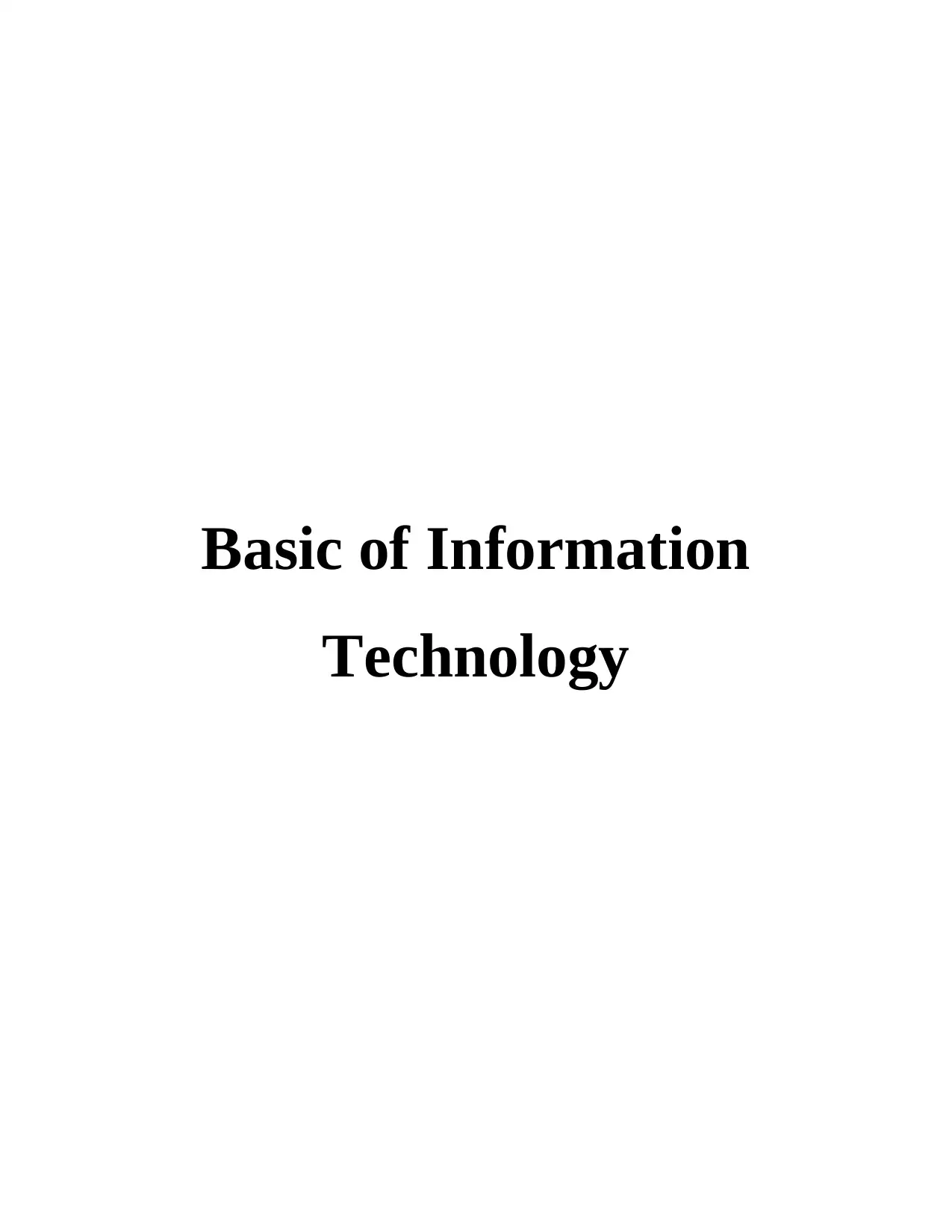
Basic of Information
Technology
Technology
Paraphrase This Document
Need a fresh take? Get an instant paraphrase of this document with our AI Paraphraser

TABLE OF CONTENTS
INTRODUCTION...........................................................................................................................1
MAIN BODY:.................................................................................................................................1
CONCLUSION:...............................................................................................................................7
REFERENCES:...............................................................................................................................8
INTRODUCTION...........................................................................................................................1
MAIN BODY:.................................................................................................................................1
CONCLUSION:...............................................................................................................................7
REFERENCES:...............................................................................................................................8
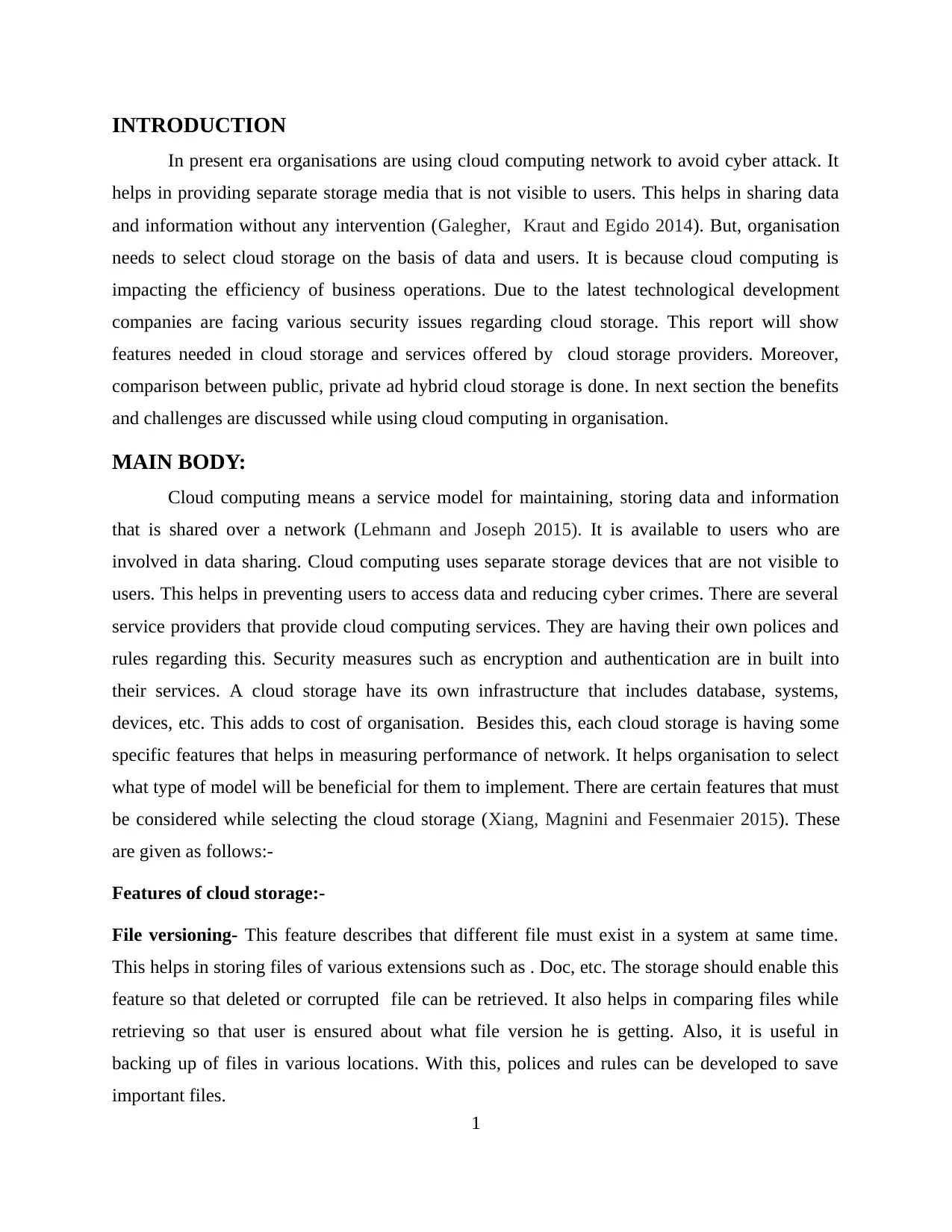
INTRODUCTION
In present era organisations are using cloud computing network to avoid cyber attack. It
helps in providing separate storage media that is not visible to users. This helps in sharing data
and information without any intervention (Galegher, Kraut and Egido 2014). But, organisation
needs to select cloud storage on the basis of data and users. It is because cloud computing is
impacting the efficiency of business operations. Due to the latest technological development
companies are facing various security issues regarding cloud storage. This report will show
features needed in cloud storage and services offered by cloud storage providers. Moreover,
comparison between public, private ad hybrid cloud storage is done. In next section the benefits
and challenges are discussed while using cloud computing in organisation.
MAIN BODY:
Cloud computing means a service model for maintaining, storing data and information
that is shared over a network (Lehmann and Joseph 2015). It is available to users who are
involved in data sharing. Cloud computing uses separate storage devices that are not visible to
users. This helps in preventing users to access data and reducing cyber crimes. There are several
service providers that provide cloud computing services. They are having their own polices and
rules regarding this. Security measures such as encryption and authentication are in built into
their services. A cloud storage have its own infrastructure that includes database, systems,
devices, etc. This adds to cost of organisation. Besides this, each cloud storage is having some
specific features that helps in measuring performance of network. It helps organisation to select
what type of model will be beneficial for them to implement. There are certain features that must
be considered while selecting the cloud storage (Xiang, Magnini and Fesenmaier 2015). These
are given as follows:-
Features of cloud storage:-
File versioning- This feature describes that different file must exist in a system at same time.
This helps in storing files of various extensions such as . Doc, etc. The storage should enable this
feature so that deleted or corrupted file can be retrieved. It also helps in comparing files while
retrieving so that user is ensured about what file version he is getting. Also, it is useful in
backing up of files in various locations. With this, polices and rules can be developed to save
important files.
1
In present era organisations are using cloud computing network to avoid cyber attack. It
helps in providing separate storage media that is not visible to users. This helps in sharing data
and information without any intervention (Galegher, Kraut and Egido 2014). But, organisation
needs to select cloud storage on the basis of data and users. It is because cloud computing is
impacting the efficiency of business operations. Due to the latest technological development
companies are facing various security issues regarding cloud storage. This report will show
features needed in cloud storage and services offered by cloud storage providers. Moreover,
comparison between public, private ad hybrid cloud storage is done. In next section the benefits
and challenges are discussed while using cloud computing in organisation.
MAIN BODY:
Cloud computing means a service model for maintaining, storing data and information
that is shared over a network (Lehmann and Joseph 2015). It is available to users who are
involved in data sharing. Cloud computing uses separate storage devices that are not visible to
users. This helps in preventing users to access data and reducing cyber crimes. There are several
service providers that provide cloud computing services. They are having their own polices and
rules regarding this. Security measures such as encryption and authentication are in built into
their services. A cloud storage have its own infrastructure that includes database, systems,
devices, etc. This adds to cost of organisation. Besides this, each cloud storage is having some
specific features that helps in measuring performance of network. It helps organisation to select
what type of model will be beneficial for them to implement. There are certain features that must
be considered while selecting the cloud storage (Xiang, Magnini and Fesenmaier 2015). These
are given as follows:-
Features of cloud storage:-
File versioning- This feature describes that different file must exist in a system at same time.
This helps in storing files of various extensions such as . Doc, etc. The storage should enable this
feature so that deleted or corrupted file can be retrieved. It also helps in comparing files while
retrieving so that user is ensured about what file version he is getting. Also, it is useful in
backing up of files in various locations. With this, polices and rules can be developed to save
important files.
1
⊘ This is a preview!⊘
Do you want full access?
Subscribe today to unlock all pages.

Trusted by 1+ million students worldwide
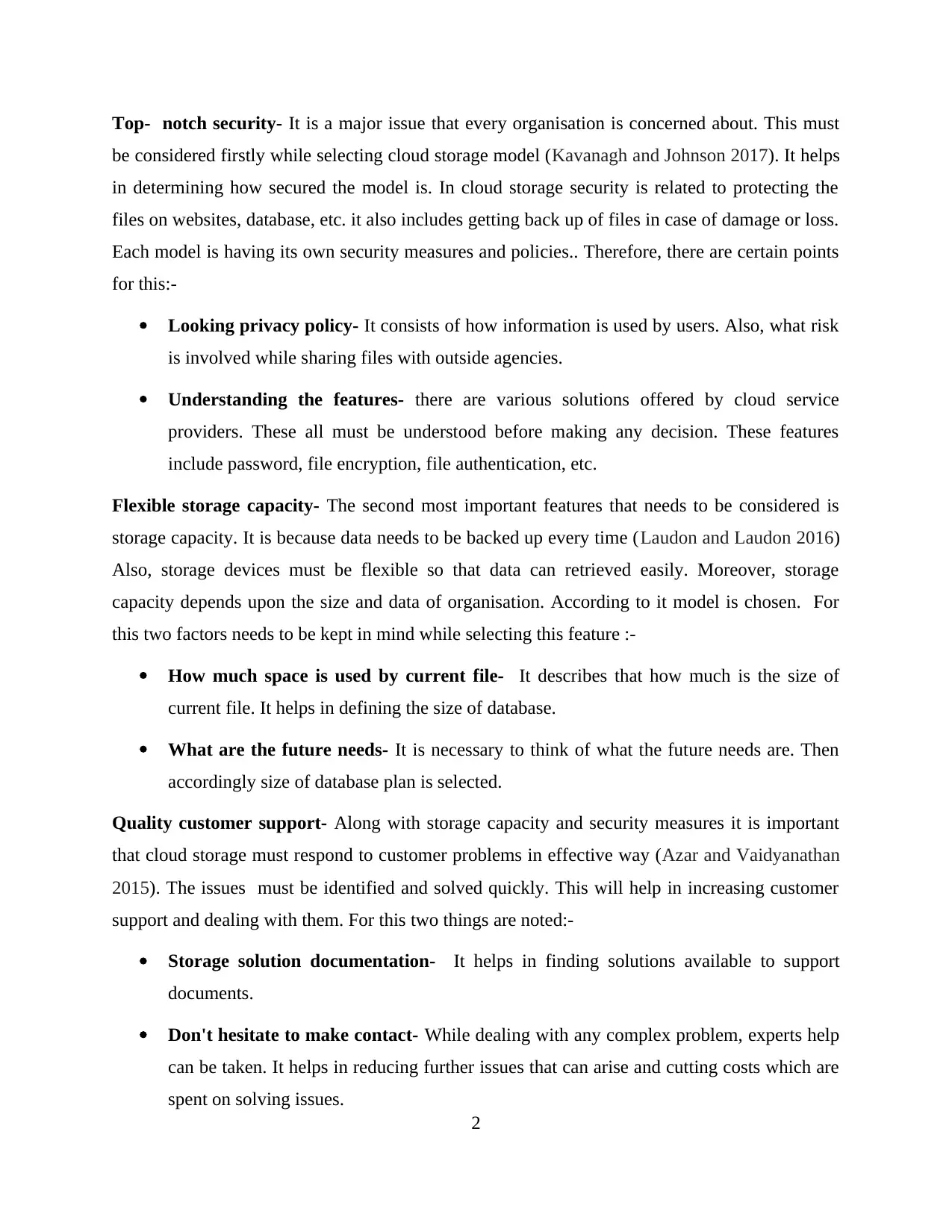
Top- notch security- It is a major issue that every organisation is concerned about. This must
be considered firstly while selecting cloud storage model (Kavanagh and Johnson 2017). It helps
in determining how secured the model is. In cloud storage security is related to protecting the
files on websites, database, etc. it also includes getting back up of files in case of damage or loss.
Each model is having its own security measures and policies.. Therefore, there are certain points
for this:-
Looking privacy policy- It consists of how information is used by users. Also, what risk
is involved while sharing files with outside agencies.
Understanding the features- there are various solutions offered by cloud service
providers. These all must be understood before making any decision. These features
include password, file encryption, file authentication, etc.
Flexible storage capacity- The second most important features that needs to be considered is
storage capacity. It is because data needs to be backed up every time (Laudon and Laudon 2016)
Also, storage devices must be flexible so that data can retrieved easily. Moreover, storage
capacity depends upon the size and data of organisation. According to it model is chosen. For
this two factors needs to be kept in mind while selecting this feature :-
How much space is used by current file- It describes that how much is the size of
current file. It helps in defining the size of database.
What are the future needs- It is necessary to think of what the future needs are. Then
accordingly size of database plan is selected.
Quality customer support- Along with storage capacity and security measures it is important
that cloud storage must respond to customer problems in effective way (Azar and Vaidyanathan
2015). The issues must be identified and solved quickly. This will help in increasing customer
support and dealing with them. For this two things are noted:-
Storage solution documentation- It helps in finding solutions available to support
documents.
Don't hesitate to make contact- While dealing with any complex problem, experts help
can be taken. It helps in reducing further issues that can arise and cutting costs which are
spent on solving issues.
2
be considered firstly while selecting cloud storage model (Kavanagh and Johnson 2017). It helps
in determining how secured the model is. In cloud storage security is related to protecting the
files on websites, database, etc. it also includes getting back up of files in case of damage or loss.
Each model is having its own security measures and policies.. Therefore, there are certain points
for this:-
Looking privacy policy- It consists of how information is used by users. Also, what risk
is involved while sharing files with outside agencies.
Understanding the features- there are various solutions offered by cloud service
providers. These all must be understood before making any decision. These features
include password, file encryption, file authentication, etc.
Flexible storage capacity- The second most important features that needs to be considered is
storage capacity. It is because data needs to be backed up every time (Laudon and Laudon 2016)
Also, storage devices must be flexible so that data can retrieved easily. Moreover, storage
capacity depends upon the size and data of organisation. According to it model is chosen. For
this two factors needs to be kept in mind while selecting this feature :-
How much space is used by current file- It describes that how much is the size of
current file. It helps in defining the size of database.
What are the future needs- It is necessary to think of what the future needs are. Then
accordingly size of database plan is selected.
Quality customer support- Along with storage capacity and security measures it is important
that cloud storage must respond to customer problems in effective way (Azar and Vaidyanathan
2015). The issues must be identified and solved quickly. This will help in increasing customer
support and dealing with them. For this two things are noted:-
Storage solution documentation- It helps in finding solutions available to support
documents.
Don't hesitate to make contact- While dealing with any complex problem, experts help
can be taken. It helps in reducing further issues that can arise and cutting costs which are
spent on solving issues.
2
Paraphrase This Document
Need a fresh take? Get an instant paraphrase of this document with our AI Paraphraser
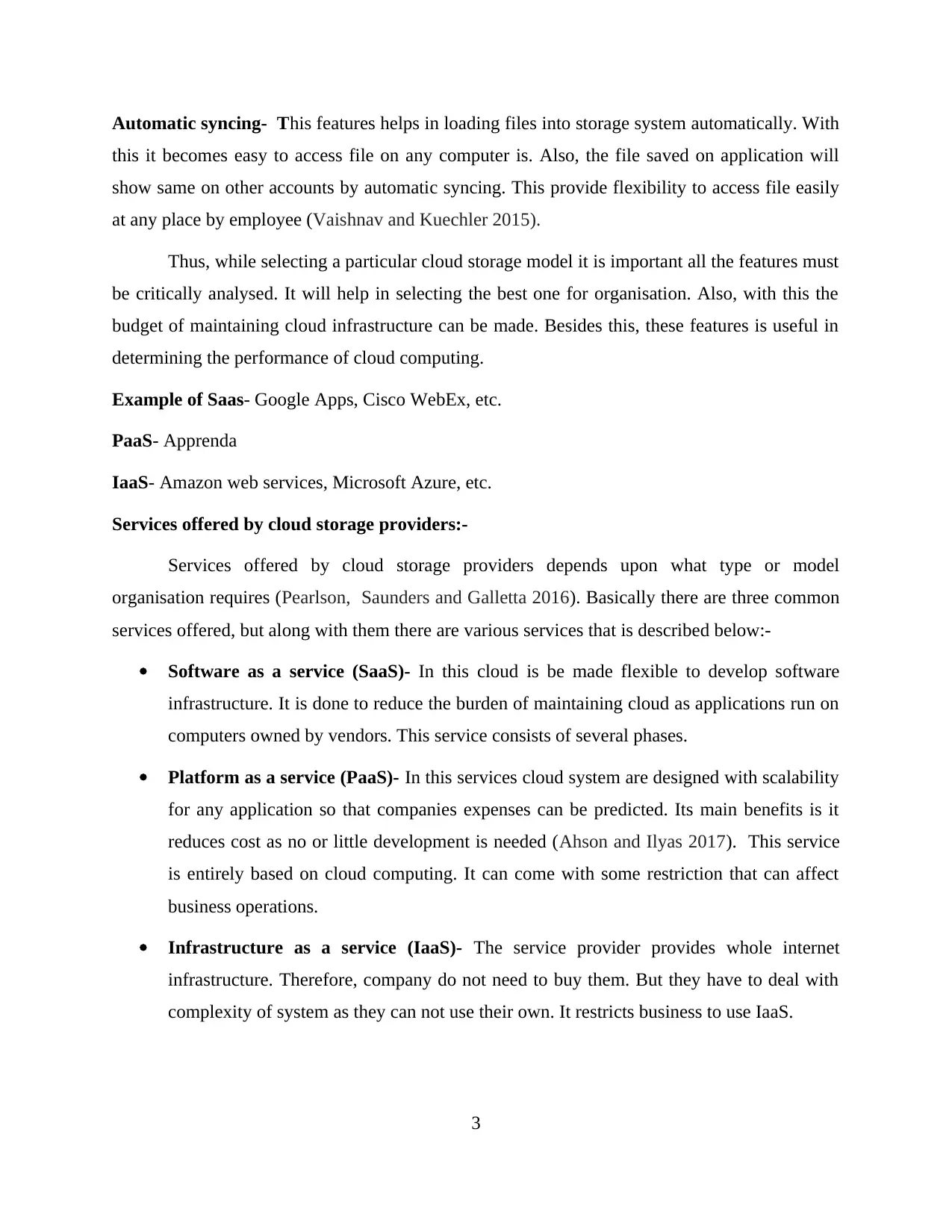
Automatic syncing- This features helps in loading files into storage system automatically. With
this it becomes easy to access file on any computer is. Also, the file saved on application will
show same on other accounts by automatic syncing. This provide flexibility to access file easily
at any place by employee (Vaishnav and Kuechler 2015).
Thus, while selecting a particular cloud storage model it is important all the features must
be critically analysed. It will help in selecting the best one for organisation. Also, with this the
budget of maintaining cloud infrastructure can be made. Besides this, these features is useful in
determining the performance of cloud computing.
Example of Saas- Google Apps, Cisco WebEx, etc.
PaaS- Apprenda
IaaS- Amazon web services, Microsoft Azure, etc.
Services offered by cloud storage providers:-
Services offered by cloud storage providers depends upon what type or model
organisation requires (Pearlson, Saunders and Galletta 2016). Basically there are three common
services offered, but along with them there are various services that is described below:-
Software as a service (SaaS)- In this cloud is be made flexible to develop software
infrastructure. It is done to reduce the burden of maintaining cloud as applications run on
computers owned by vendors. This service consists of several phases.
Platform as a service (PaaS)- In this services cloud system are designed with scalability
for any application so that companies expenses can be predicted. Its main benefits is it
reduces cost as no or little development is needed (Ahson and Ilyas 2017). This service
is entirely based on cloud computing. It can come with some restriction that can affect
business operations.
Infrastructure as a service (IaaS)- The service provider provides whole internet
infrastructure. Therefore, company do not need to buy them. But they have to deal with
complexity of system as they can not use their own. It restricts business to use IaaS.
3
this it becomes easy to access file on any computer is. Also, the file saved on application will
show same on other accounts by automatic syncing. This provide flexibility to access file easily
at any place by employee (Vaishnav and Kuechler 2015).
Thus, while selecting a particular cloud storage model it is important all the features must
be critically analysed. It will help in selecting the best one for organisation. Also, with this the
budget of maintaining cloud infrastructure can be made. Besides this, these features is useful in
determining the performance of cloud computing.
Example of Saas- Google Apps, Cisco WebEx, etc.
PaaS- Apprenda
IaaS- Amazon web services, Microsoft Azure, etc.
Services offered by cloud storage providers:-
Services offered by cloud storage providers depends upon what type or model
organisation requires (Pearlson, Saunders and Galletta 2016). Basically there are three common
services offered, but along with them there are various services that is described below:-
Software as a service (SaaS)- In this cloud is be made flexible to develop software
infrastructure. It is done to reduce the burden of maintaining cloud as applications run on
computers owned by vendors. This service consists of several phases.
Platform as a service (PaaS)- In this services cloud system are designed with scalability
for any application so that companies expenses can be predicted. Its main benefits is it
reduces cost as no or little development is needed (Ahson and Ilyas 2017). This service
is entirely based on cloud computing. It can come with some restriction that can affect
business operations.
Infrastructure as a service (IaaS)- The service provider provides whole internet
infrastructure. Therefore, company do not need to buy them. But they have to deal with
complexity of system as they can not use their own. It restricts business to use IaaS.
3
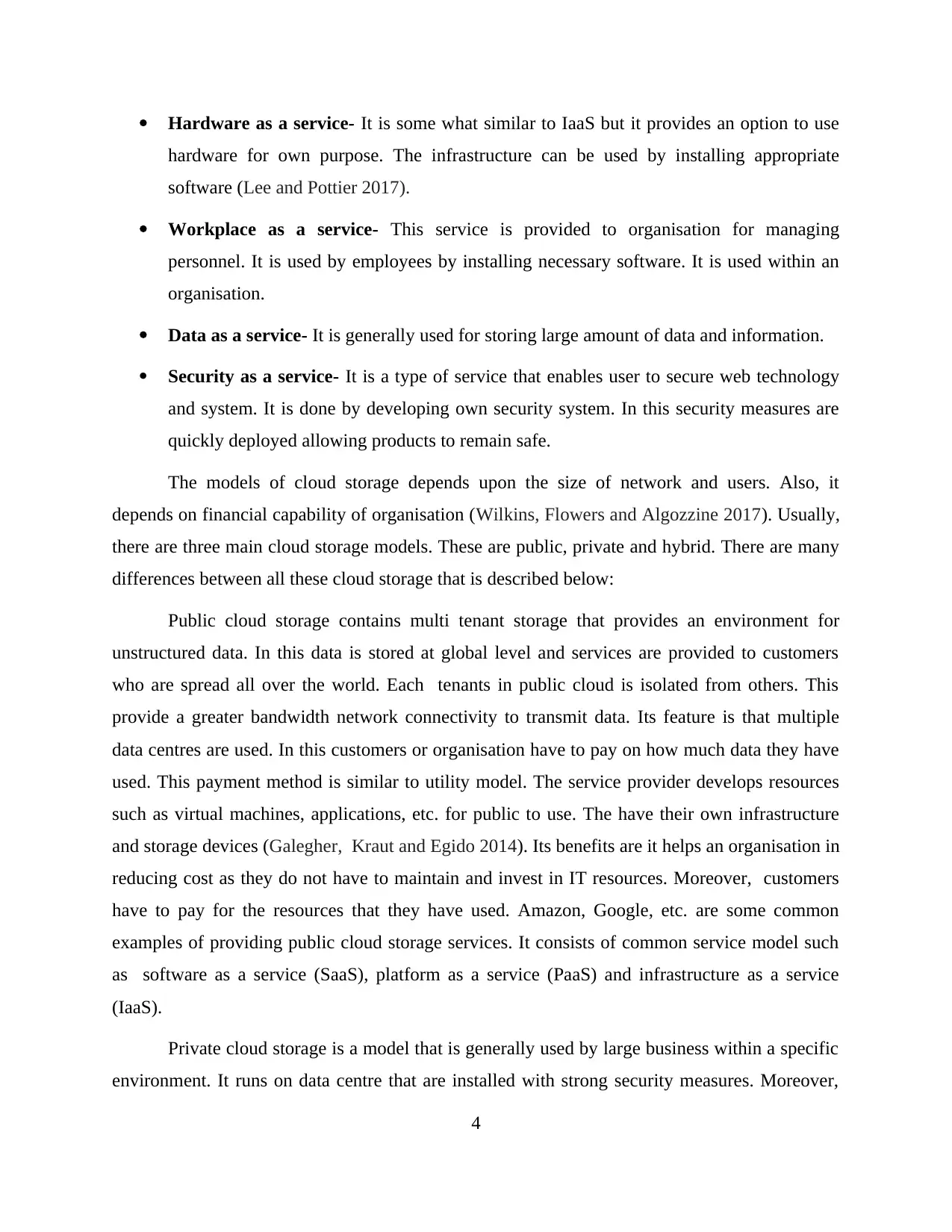
Hardware as a service- It is some what similar to IaaS but it provides an option to use
hardware for own purpose. The infrastructure can be used by installing appropriate
software (Lee and Pottier 2017).
Workplace as a service- This service is provided to organisation for managing
personnel. It is used by employees by installing necessary software. It is used within an
organisation.
Data as a service- It is generally used for storing large amount of data and information.
Security as a service- It is a type of service that enables user to secure web technology
and system. It is done by developing own security system. In this security measures are
quickly deployed allowing products to remain safe.
The models of cloud storage depends upon the size of network and users. Also, it
depends on financial capability of organisation (Wilkins, Flowers and Algozzine 2017). Usually,
there are three main cloud storage models. These are public, private and hybrid. There are many
differences between all these cloud storage that is described below:
Public cloud storage contains multi tenant storage that provides an environment for
unstructured data. In this data is stored at global level and services are provided to customers
who are spread all over the world. Each tenants in public cloud is isolated from others. This
provide a greater bandwidth network connectivity to transmit data. Its feature is that multiple
data centres are used. In this customers or organisation have to pay on how much data they have
used. This payment method is similar to utility model. The service provider develops resources
such as virtual machines, applications, etc. for public to use. The have their own infrastructure
and storage devices (Galegher, Kraut and Egido 2014). Its benefits are it helps an organisation in
reducing cost as they do not have to maintain and invest in IT resources. Moreover, customers
have to pay for the resources that they have used. Amazon, Google, etc. are some common
examples of providing public cloud storage services. It consists of common service model such
as software as a service (SaaS), platform as a service (PaaS) and infrastructure as a service
(IaaS).
Private cloud storage is a model that is generally used by large business within a specific
environment. It runs on data centre that are installed with strong security measures. Moreover,
4
hardware for own purpose. The infrastructure can be used by installing appropriate
software (Lee and Pottier 2017).
Workplace as a service- This service is provided to organisation for managing
personnel. It is used by employees by installing necessary software. It is used within an
organisation.
Data as a service- It is generally used for storing large amount of data and information.
Security as a service- It is a type of service that enables user to secure web technology
and system. It is done by developing own security system. In this security measures are
quickly deployed allowing products to remain safe.
The models of cloud storage depends upon the size of network and users. Also, it
depends on financial capability of organisation (Wilkins, Flowers and Algozzine 2017). Usually,
there are three main cloud storage models. These are public, private and hybrid. There are many
differences between all these cloud storage that is described below:
Public cloud storage contains multi tenant storage that provides an environment for
unstructured data. In this data is stored at global level and services are provided to customers
who are spread all over the world. Each tenants in public cloud is isolated from others. This
provide a greater bandwidth network connectivity to transmit data. Its feature is that multiple
data centres are used. In this customers or organisation have to pay on how much data they have
used. This payment method is similar to utility model. The service provider develops resources
such as virtual machines, applications, etc. for public to use. The have their own infrastructure
and storage devices (Galegher, Kraut and Egido 2014). Its benefits are it helps an organisation in
reducing cost as they do not have to maintain and invest in IT resources. Moreover, customers
have to pay for the resources that they have used. Amazon, Google, etc. are some common
examples of providing public cloud storage services. It consists of common service model such
as software as a service (SaaS), platform as a service (PaaS) and infrastructure as a service
(IaaS).
Private cloud storage is a model that is generally used by large business within a specific
environment. It runs on data centre that are installed with strong security measures. Moreover,
4
⊘ This is a preview!⊘
Do you want full access?
Subscribe today to unlock all pages.

Trusted by 1+ million students worldwide
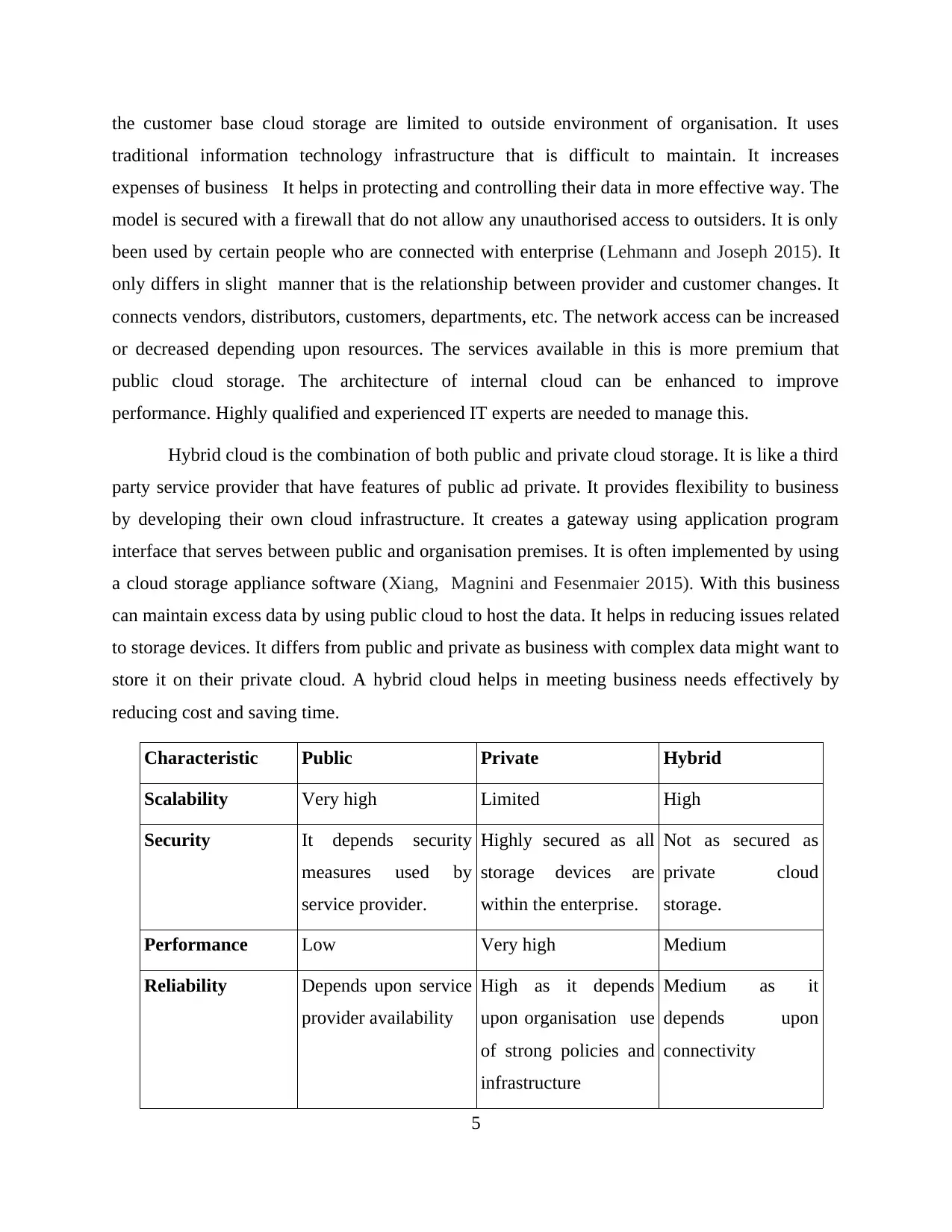
the customer base cloud storage are limited to outside environment of organisation. It uses
traditional information technology infrastructure that is difficult to maintain. It increases
expenses of business It helps in protecting and controlling their data in more effective way. The
model is secured with a firewall that do not allow any unauthorised access to outsiders. It is only
been used by certain people who are connected with enterprise (Lehmann and Joseph 2015). It
only differs in slight manner that is the relationship between provider and customer changes. It
connects vendors, distributors, customers, departments, etc. The network access can be increased
or decreased depending upon resources. The services available in this is more premium that
public cloud storage. The architecture of internal cloud can be enhanced to improve
performance. Highly qualified and experienced IT experts are needed to manage this.
Hybrid cloud is the combination of both public and private cloud storage. It is like a third
party service provider that have features of public ad private. It provides flexibility to business
by developing their own cloud infrastructure. It creates a gateway using application program
interface that serves between public and organisation premises. It is often implemented by using
a cloud storage appliance software (Xiang, Magnini and Fesenmaier 2015). With this business
can maintain excess data by using public cloud to host the data. It helps in reducing issues related
to storage devices. It differs from public and private as business with complex data might want to
store it on their private cloud. A hybrid cloud helps in meeting business needs effectively by
reducing cost and saving time.
Characteristic Public Private Hybrid
Scalability Very high Limited High
Security It depends security
measures used by
service provider.
Highly secured as all
storage devices are
within the enterprise.
Not as secured as
private cloud
storage.
Performance Low Very high Medium
Reliability Depends upon service
provider availability
High as it depends
upon organisation use
of strong policies and
infrastructure
Medium as it
depends upon
connectivity
5
traditional information technology infrastructure that is difficult to maintain. It increases
expenses of business It helps in protecting and controlling their data in more effective way. The
model is secured with a firewall that do not allow any unauthorised access to outsiders. It is only
been used by certain people who are connected with enterprise (Lehmann and Joseph 2015). It
only differs in slight manner that is the relationship between provider and customer changes. It
connects vendors, distributors, customers, departments, etc. The network access can be increased
or decreased depending upon resources. The services available in this is more premium that
public cloud storage. The architecture of internal cloud can be enhanced to improve
performance. Highly qualified and experienced IT experts are needed to manage this.
Hybrid cloud is the combination of both public and private cloud storage. It is like a third
party service provider that have features of public ad private. It provides flexibility to business
by developing their own cloud infrastructure. It creates a gateway using application program
interface that serves between public and organisation premises. It is often implemented by using
a cloud storage appliance software (Xiang, Magnini and Fesenmaier 2015). With this business
can maintain excess data by using public cloud to host the data. It helps in reducing issues related
to storage devices. It differs from public and private as business with complex data might want to
store it on their private cloud. A hybrid cloud helps in meeting business needs effectively by
reducing cost and saving time.
Characteristic Public Private Hybrid
Scalability Very high Limited High
Security It depends security
measures used by
service provider.
Highly secured as all
storage devices are
within the enterprise.
Not as secured as
private cloud
storage.
Performance Low Very high Medium
Reliability Depends upon service
provider availability
High as it depends
upon organisation use
of strong policies and
infrastructure
Medium as it
depends upon
connectivity
5
Paraphrase This Document
Need a fresh take? Get an instant paraphrase of this document with our AI Paraphraser
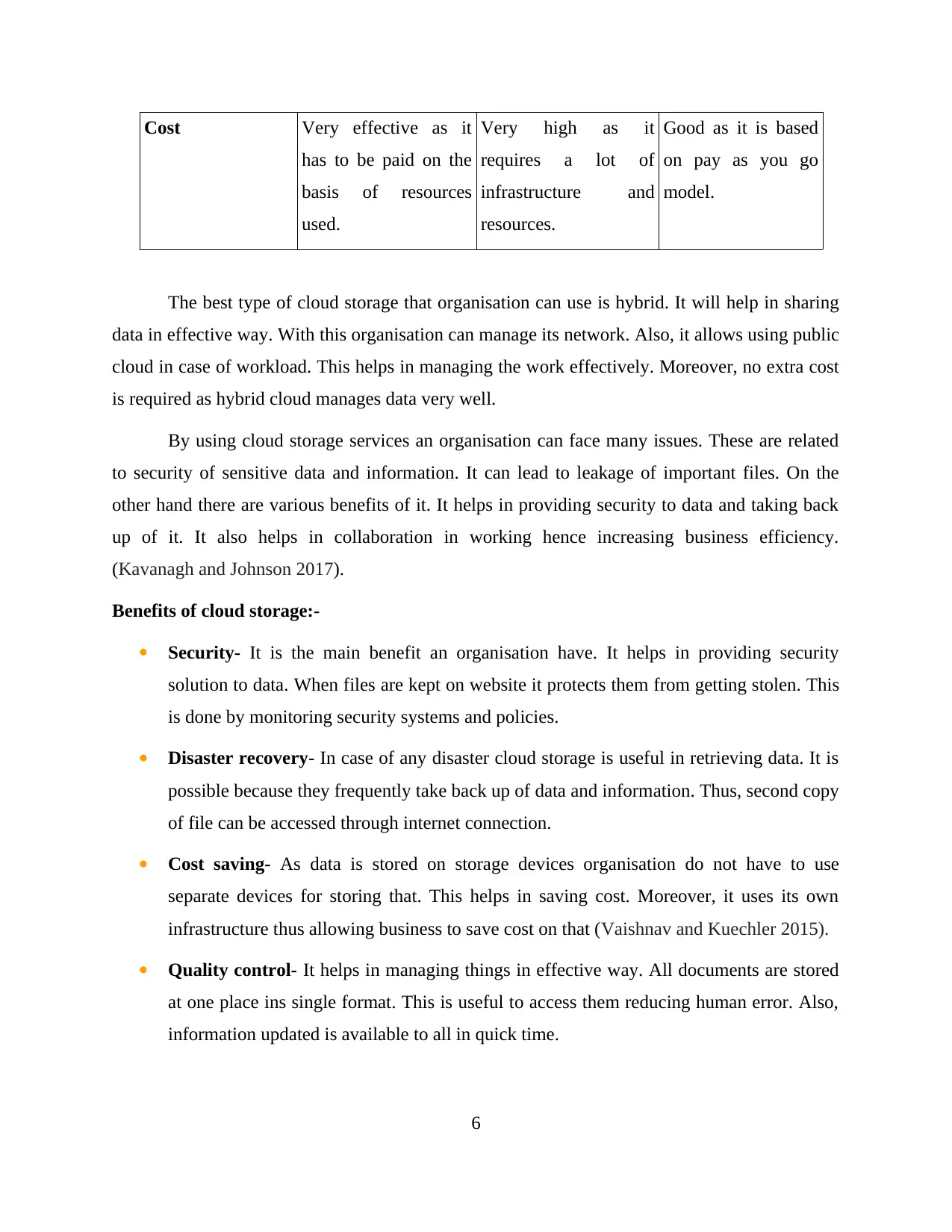
Cost Very effective as it
has to be paid on the
basis of resources
used.
Very high as it
requires a lot of
infrastructure and
resources.
Good as it is based
on pay as you go
model.
The best type of cloud storage that organisation can use is hybrid. It will help in sharing
data in effective way. With this organisation can manage its network. Also, it allows using public
cloud in case of workload. This helps in managing the work effectively. Moreover, no extra cost
is required as hybrid cloud manages data very well.
By using cloud storage services an organisation can face many issues. These are related
to security of sensitive data and information. It can lead to leakage of important files. On the
other hand there are various benefits of it. It helps in providing security to data and taking back
up of it. It also helps in collaboration in working hence increasing business efficiency.
(Kavanagh and Johnson 2017).
Benefits of cloud storage:-
Security- It is the main benefit an organisation have. It helps in providing security
solution to data. When files are kept on website it protects them from getting stolen. This
is done by monitoring security systems and policies.
Disaster recovery- In case of any disaster cloud storage is useful in retrieving data. It is
possible because they frequently take back up of data and information. Thus, second copy
of file can be accessed through internet connection.
Cost saving- As data is stored on storage devices organisation do not have to use
separate devices for storing that. This helps in saving cost. Moreover, it uses its own
infrastructure thus allowing business to save cost on that (Vaishnav and Kuechler 2015).
Quality control- It helps in managing things in effective way. All documents are stored
at one place ins single format. This is useful to access them reducing human error. Also,
information updated is available to all in quick time.
6
has to be paid on the
basis of resources
used.
Very high as it
requires a lot of
infrastructure and
resources.
Good as it is based
on pay as you go
model.
The best type of cloud storage that organisation can use is hybrid. It will help in sharing
data in effective way. With this organisation can manage its network. Also, it allows using public
cloud in case of workload. This helps in managing the work effectively. Moreover, no extra cost
is required as hybrid cloud manages data very well.
By using cloud storage services an organisation can face many issues. These are related
to security of sensitive data and information. It can lead to leakage of important files. On the
other hand there are various benefits of it. It helps in providing security to data and taking back
up of it. It also helps in collaboration in working hence increasing business efficiency.
(Kavanagh and Johnson 2017).
Benefits of cloud storage:-
Security- It is the main benefit an organisation have. It helps in providing security
solution to data. When files are kept on website it protects them from getting stolen. This
is done by monitoring security systems and policies.
Disaster recovery- In case of any disaster cloud storage is useful in retrieving data. It is
possible because they frequently take back up of data and information. Thus, second copy
of file can be accessed through internet connection.
Cost saving- As data is stored on storage devices organisation do not have to use
separate devices for storing that. This helps in saving cost. Moreover, it uses its own
infrastructure thus allowing business to save cost on that (Vaishnav and Kuechler 2015).
Quality control- It helps in managing things in effective way. All documents are stored
at one place ins single format. This is useful to access them reducing human error. Also,
information updated is available to all in quick time.
6
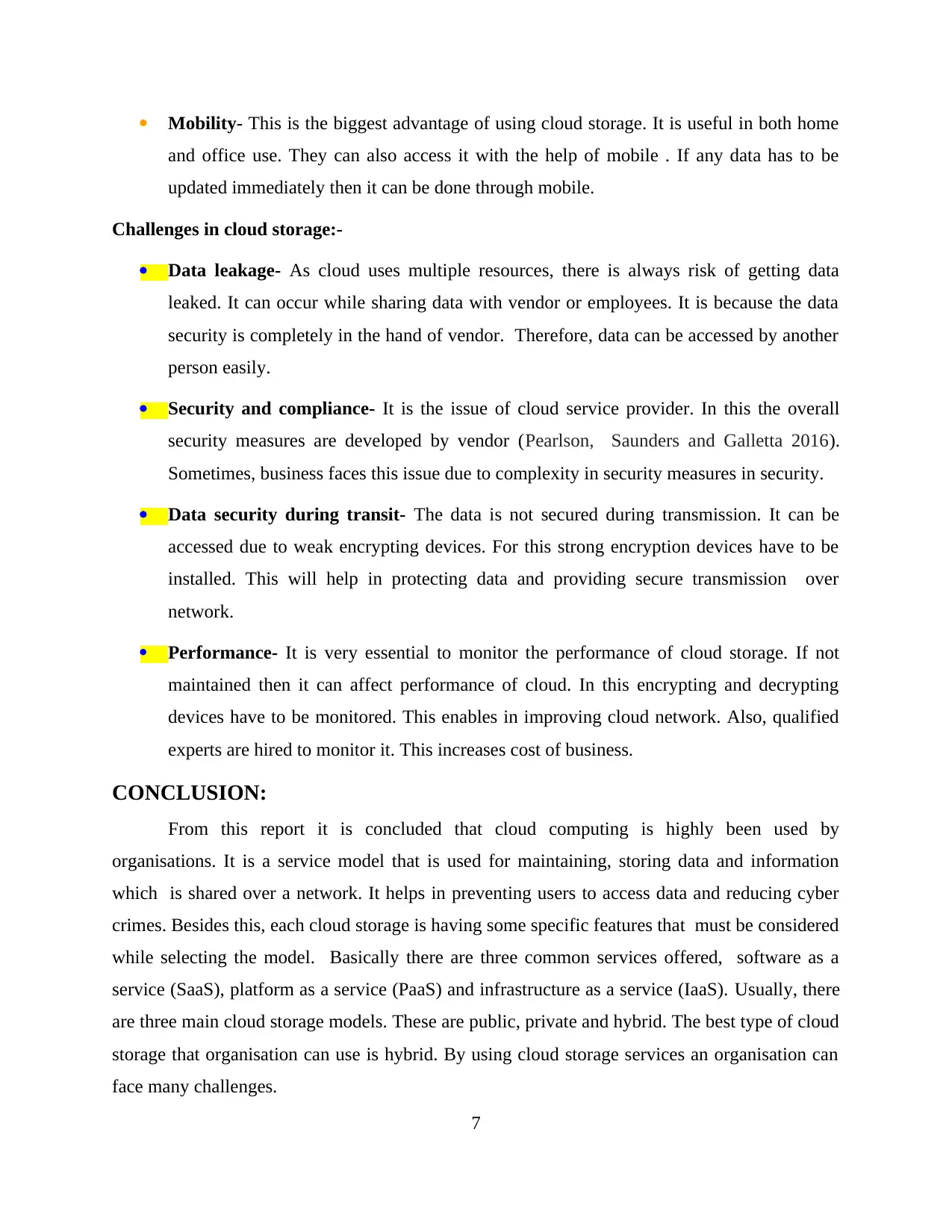
Mobility- This is the biggest advantage of using cloud storage. It is useful in both home
and office use. They can also access it with the help of mobile . If any data has to be
updated immediately then it can be done through mobile.
Challenges in cloud storage:-
Data leakage- As cloud uses multiple resources, there is always risk of getting data
leaked. It can occur while sharing data with vendor or employees. It is because the data
security is completely in the hand of vendor. Therefore, data can be accessed by another
person easily.
Security and compliance- It is the issue of cloud service provider. In this the overall
security measures are developed by vendor (Pearlson, Saunders and Galletta 2016).
Sometimes, business faces this issue due to complexity in security measures in security.
Data security during transit- The data is not secured during transmission. It can be
accessed due to weak encrypting devices. For this strong encryption devices have to be
installed. This will help in protecting data and providing secure transmission over
network.
Performance- It is very essential to monitor the performance of cloud storage. If not
maintained then it can affect performance of cloud. In this encrypting and decrypting
devices have to be monitored. This enables in improving cloud network. Also, qualified
experts are hired to monitor it. This increases cost of business.
CONCLUSION:
From this report it is concluded that cloud computing is highly been used by
organisations. It is a service model that is used for maintaining, storing data and information
which is shared over a network. It helps in preventing users to access data and reducing cyber
crimes. Besides this, each cloud storage is having some specific features that must be considered
while selecting the model. Basically there are three common services offered, software as a
service (SaaS), platform as a service (PaaS) and infrastructure as a service (IaaS). Usually, there
are three main cloud storage models. These are public, private and hybrid. The best type of cloud
storage that organisation can use is hybrid. By using cloud storage services an organisation can
face many challenges.
7
and office use. They can also access it with the help of mobile . If any data has to be
updated immediately then it can be done through mobile.
Challenges in cloud storage:-
Data leakage- As cloud uses multiple resources, there is always risk of getting data
leaked. It can occur while sharing data with vendor or employees. It is because the data
security is completely in the hand of vendor. Therefore, data can be accessed by another
person easily.
Security and compliance- It is the issue of cloud service provider. In this the overall
security measures are developed by vendor (Pearlson, Saunders and Galletta 2016).
Sometimes, business faces this issue due to complexity in security measures in security.
Data security during transit- The data is not secured during transmission. It can be
accessed due to weak encrypting devices. For this strong encryption devices have to be
installed. This will help in protecting data and providing secure transmission over
network.
Performance- It is very essential to monitor the performance of cloud storage. If not
maintained then it can affect performance of cloud. In this encrypting and decrypting
devices have to be monitored. This enables in improving cloud network. Also, qualified
experts are hired to monitor it. This increases cost of business.
CONCLUSION:
From this report it is concluded that cloud computing is highly been used by
organisations. It is a service model that is used for maintaining, storing data and information
which is shared over a network. It helps in preventing users to access data and reducing cyber
crimes. Besides this, each cloud storage is having some specific features that must be considered
while selecting the model. Basically there are three common services offered, software as a
service (SaaS), platform as a service (PaaS) and infrastructure as a service (IaaS). Usually, there
are three main cloud storage models. These are public, private and hybrid. The best type of cloud
storage that organisation can use is hybrid. By using cloud storage services an organisation can
face many challenges.
7
⊘ This is a preview!⊘
Do you want full access?
Subscribe today to unlock all pages.

Trusted by 1+ million students worldwide

8
Paraphrase This Document
Need a fresh take? Get an instant paraphrase of this document with our AI Paraphraser
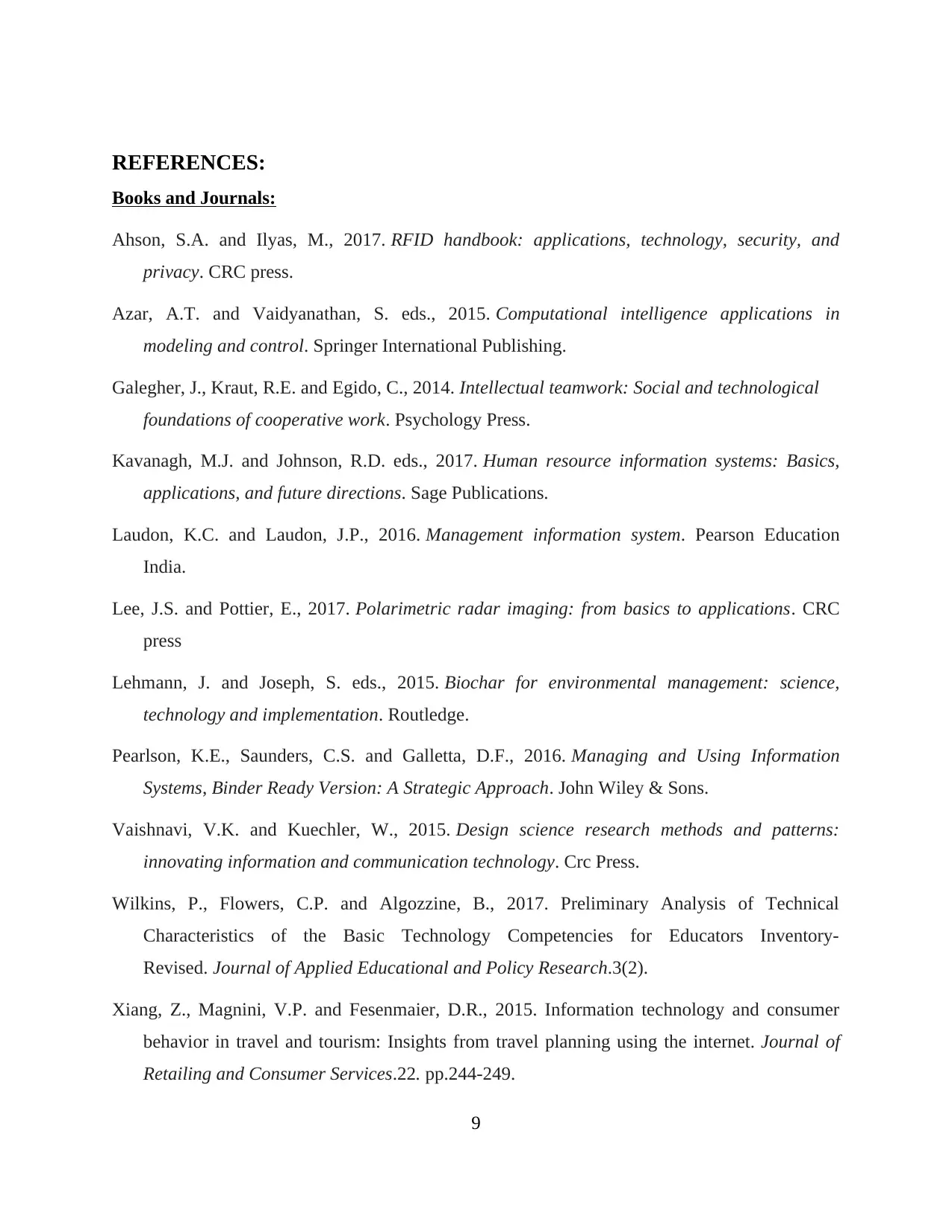
REFERENCES:
Books and Journals:
Ahson, S.A. and Ilyas, M., 2017. RFID handbook: applications, technology, security, and
privacy. CRC press.
Azar, A.T. and Vaidyanathan, S. eds., 2015. Computational intelligence applications in
modeling and control. Springer International Publishing.
Galegher, J., Kraut, R.E. and Egido, C., 2014. Intellectual teamwork: Social and technological
foundations of cooperative work. Psychology Press.
Kavanagh, M.J. and Johnson, R.D. eds., 2017. Human resource information systems: Basics,
applications, and future directions. Sage Publications.
Laudon, K.C. and Laudon, J.P., 2016. Management information system. Pearson Education
India.
Lee, J.S. and Pottier, E., 2017. Polarimetric radar imaging: from basics to applications. CRC
press
Lehmann, J. and Joseph, S. eds., 2015. Biochar for environmental management: science,
technology and implementation. Routledge.
Pearlson, K.E., Saunders, C.S. and Galletta, D.F., 2016. Managing and Using Information
Systems, Binder Ready Version: A Strategic Approach. John Wiley & Sons.
Vaishnavi, V.K. and Kuechler, W., 2015. Design science research methods and patterns:
innovating information and communication technology. Crc Press.
Wilkins, P., Flowers, C.P. and Algozzine, B., 2017. Preliminary Analysis of Technical
Characteristics of the Basic Technology Competencies for Educators Inventory-
Revised. Journal of Applied Educational and Policy Research.3(2).
Xiang, Z., Magnini, V.P. and Fesenmaier, D.R., 2015. Information technology and consumer
behavior in travel and tourism: Insights from travel planning using the internet. Journal of
Retailing and Consumer Services.22. pp.244-249.
9
Books and Journals:
Ahson, S.A. and Ilyas, M., 2017. RFID handbook: applications, technology, security, and
privacy. CRC press.
Azar, A.T. and Vaidyanathan, S. eds., 2015. Computational intelligence applications in
modeling and control. Springer International Publishing.
Galegher, J., Kraut, R.E. and Egido, C., 2014. Intellectual teamwork: Social and technological
foundations of cooperative work. Psychology Press.
Kavanagh, M.J. and Johnson, R.D. eds., 2017. Human resource information systems: Basics,
applications, and future directions. Sage Publications.
Laudon, K.C. and Laudon, J.P., 2016. Management information system. Pearson Education
India.
Lee, J.S. and Pottier, E., 2017. Polarimetric radar imaging: from basics to applications. CRC
press
Lehmann, J. and Joseph, S. eds., 2015. Biochar for environmental management: science,
technology and implementation. Routledge.
Pearlson, K.E., Saunders, C.S. and Galletta, D.F., 2016. Managing and Using Information
Systems, Binder Ready Version: A Strategic Approach. John Wiley & Sons.
Vaishnavi, V.K. and Kuechler, W., 2015. Design science research methods and patterns:
innovating information and communication technology. Crc Press.
Wilkins, P., Flowers, C.P. and Algozzine, B., 2017. Preliminary Analysis of Technical
Characteristics of the Basic Technology Competencies for Educators Inventory-
Revised. Journal of Applied Educational and Policy Research.3(2).
Xiang, Z., Magnini, V.P. and Fesenmaier, D.R., 2015. Information technology and consumer
behavior in travel and tourism: Insights from travel planning using the internet. Journal of
Retailing and Consumer Services.22. pp.244-249.
9
1 out of 11
Related Documents
Your All-in-One AI-Powered Toolkit for Academic Success.
+13062052269
info@desklib.com
Available 24*7 on WhatsApp / Email
![[object Object]](/_next/static/media/star-bottom.7253800d.svg)
Unlock your academic potential
Copyright © 2020–2025 A2Z Services. All Rights Reserved. Developed and managed by ZUCOL.

